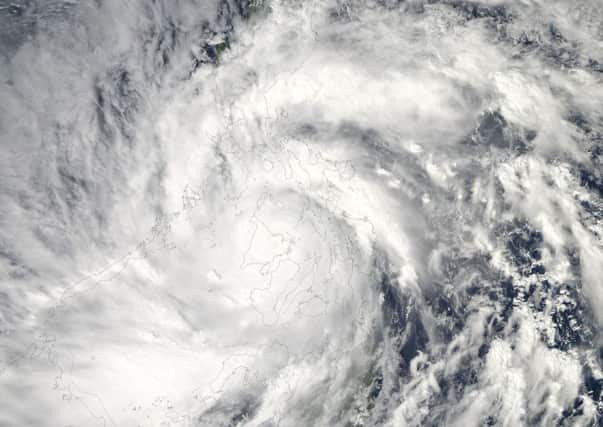Was Typhoon Haiyan a product of our changing climate?


THE harrowing stories that have been filtering out of the Philippines since the weekend have, at times, been almost too painful to hear.
The sheer scale of the damage wrought by Typhoon Haiyan has shocked people all over the world, but with the relief effort underway questions are now being asked if this devastating storm was caused by climate change.
Advertisement
Hide AdAdvertisement
Hide AdIt’s something that was raised by the head of the Philippines delegation at UN climate talks in Poland earlier this week.
In an emotional speech that reduced other delegates to tears, Yeb Sano linked the damage caused by the typhoon to a changing climate and said he would stop eating until “meaningful” progress had been made.
Mr Sano, who had just found out that his family living in one of the worst-hit areas had survived, said he was not only speaking for those who lost their lives but also the thousands who were now orphans.
In an act of solidarity he told the meeting his fast would last until “we stop this madness.”
Advertisement
Hide AdAdvertisement
Hide AdIt was a heartfelt speech that brought a standing ovation from those present and has put more pressure on political leaders to tackle the issue more effectively.
World carbon dioxide pollution levels are accelerating and reached a record high in 2012, and the UN weather agency says they are now way beyond the upper limit that some scientists and environmental groups regard as a safe level.
Carbon dioxide, which traps heat just like in a greenhouse, accounts for three-quarters of the planet’s gases that scientists say are causing climate change, while the warming of the atmosphere and the oceans creates more energy which, in turn, increases the likelihood of violent storms like Typhoon Haiyan.
Around half of last year’s extreme weather events have been linked to climate change, according to new research edited by scientists from the National Oceanic and Atmospheric Administration and The Met Office. The researchers said climate change helped drive the record loss of Arctic sea ice and fuelled the devastating storm surge of Hurricane Sandy.
Advertisement
Hide AdAdvertisement
Hide AdHowever, not all extreme weather can be blamed on climate change. It wasn’t responsible for Britain’s miserable summer last year and scientists haven’t found a link with the droughts that hit large swathes of eastern Africa.
It’s too soon for any research to make a direct connection between climate change and the recent typhoon but there is evidence that there’s a greater risk of more intense storms.
“It’s difficult to say if this is the result of climate change but we are seeing more typhoons and storms and the fact they are more frequent has been ascribed by people to climate change,” says Professor Grant Bigg, from the department of Geography at the University of Sheffield.
Last week, a report compiled by the UK’s official advisory body, the Committee on Climate Change, said the world is starting to tackle climate change. However, the report also warned that cuts in emissions are still well short of what scientists say is needed to stabilise the climate.
Advertisement
Hide AdAdvertisement
Hide AdNevertheless, there is good news as governments wake up to the threat posed by droughts, floods and food shortages. In the United States, shale gas production has forced down emissions and Europe, particularly countries like Germany with its commitment to solar and wind power, has also seen emissions drop.
China, too, with its mammoth dam-building programme and huge solar farms is trying to push down its emissions.
But Prof Bigg says countries like China still have a lot of work to do. “When you look at their emissions relative to say a decade ago they’ve actually increased quite a lot.”
He points out that there is a time lag between the build up of energy and the extreme weather events we see around the world and warns that the situation is probably going to get worse before it gets better.
Advertisement
Hide AdAdvertisement
Hide Ad“Even if we are really good and switch over power generation to renewables and become more efficient there are things already in the system and changes occurring we can’t stop,” he says. “But if we don’t start now then we wont have a chance in a few decades.”
He says there needs to be a global cap on emissions to help keep the average increase in temperature within the 2C threshold.
“The consensus is that changes are happening and we need to do something about it. If we don’t we’re looking at a very unpleasant future in the next century.”